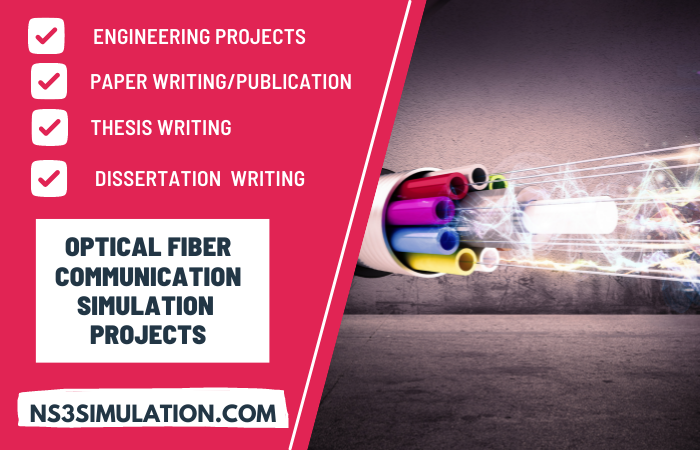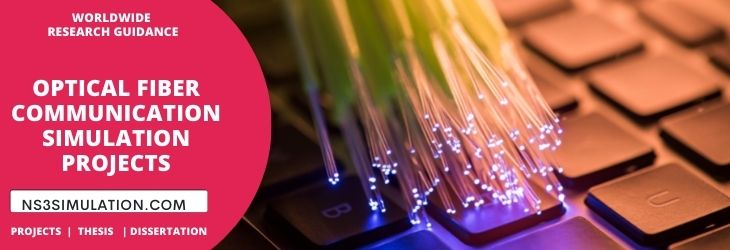Generally, optical fibers are used in network communications to reduce the vulnerabilities of radio frequencies, which is called optical fiber communication. Apart from this, optical fibers are solitary fiber cables in which lightweight sensors are getting exposed.
In this article, we deliberately stated to you the interesting phases involved in the optical fiber communication simulation projects with crystal clear notes!!!!
At the end of this article, you are educated on the prevailing concepts in optical fiber communication. Our experts have initiated the article with the overview and eminent components of optical networking. Let us get into the article.
What is Optical Networking?
- Data transmitted to the each & every nodes
- Communication devices are tied with the fiber and ethernet cable wires
- Highly adaptive in nature compared to metal cables
- Great capacity to transmit the huge data volumes with effective bandwidth
- Security and the power loss reduction is the key factor
- Electromagnetic intrusions are aided by fiber cables
Optical networking uses fiber optic cables and delivers the information in the form of light sensors. They use several components to run their processes. Shall we have the component section? Come let’s have the quick insights into that.
What are the Components of Optical Networking System?
- Wave Division Multiplexer
- Optical Amplifier, Splitters & Switch
- OADM- Optical Add Drop Multiplexer
- Multiplexer or Demultiplexer
- ROADM- Reconfigurable Optical Add Drop Multiplexer
- LED- Light Source
- Single-Mode/ Multi-Mode Fibers
- OADM Circulator
The listed above are the dominant components consisting of the optical systems. Each and every component is used to progress the significant aspects presented in telecommunication. For instance, Optical splitters are used to propagate the signals in the diverse fiber paths. Electrical conversion is not needed in the optical switches to transmit the light signals among the various ports. Circulators are interconnecting the presented elements. We hope that you are getting the points as stated in the above passage.
Telecommunication systems and optical systems are twinned fundamentally. Fiber cables are mostly used in telecommunications to transmit the data from one node to another node in implementing optical fiber communication simulation projects. Additionally, they are dynamic and easy to implement. Yes, we are going to list the applications in which fiber cables get employed.
List of Optical Fiber Communication Applications
- Data Storage Systems
- Commercial & Industrial
- Networking
- Telecommunications
- Data Transfers
- Trade Industries
- Broadcasting
- Communication
- Medical Environments
Every network setup is done according to the network topologies for their effective interactions among the internet and intranet. Likewise, optical network communications are subject to some of the topologies. In fact, our researchers felt that mentioning the topologies would highly help the students who are actually a beginner in these areas.
List of Topologies for Optical Fiber Communication
- Ring
- Dual Bus
- Torus
- Hypercube
The aforementioned are some of the topologies used in optical fiber communication. Positioning the network environment according to the topologies will help the administrator to handle the network wisely. For example, the Manhattan street network setup is done with the torus topology model. Moreover, these topologies are not only used presented but also there is plenty of network topologies are exist.
On the other hand, these topologies can be signified in the suggested projects of your institution. If you are proactive in doing optical fiber communication simulation projects then you can start your workings immediately. You can fuse with our experts to yield the best results among others in an incredible manner. Our technical crew has listed the latest research topics of optical fiber communication for the ease of your understanding.
Research Topics in Optical Fiber Communication
- Enhanced Optical Submarine Configurations
- Optical Transmission- Ultra Long Haul
- Enriched Optical Amplification Systems
- Energy Minimizing & Node-to-Node Routing
- Network Security
- Network Privacy
As the technology industry is subject to various attacks, the security of the same is questioned. Similar to these cyber-attacks, the optical network is facing so many attacks and malicious activities in it. Hence we can have the blockchain methods to eradicate attacks arising in the optical network as mentioned in the upcoming section
Optical Network Security
- Data Burst Duplicate Attacks
- Data Burst Redirection Attacks
- BHP Flooding Attacks
These are some of the attacks that get eliminated by blockchain security. Our technical team is very familiar with handling cyber security attacks and other attacks. The experts of our concern are the top engineers selected out from the knowledge hunt. In addition to these security attacks, we wanted to list out the algorithms. On the other hand, some security algorithms are used to prevent the optical fiber communication simulation projects. In this regard, let us try to understand the optical fiber communication algorithms.
Security Algorithms for Optical Fiber Communications
- RSA Security
- HMAC
- MD5
- IDE
- AES
- Blowfish
- Twofish
- TripleDES
What is the Latest Trend in Optical Fiber Technology?
- Modulation & Demodulation
- Channel Modeling (5G)
- Nonlinear-Coherent Approaches (QPSK)
- Dual Polarization Methods (CO-OFDM)
- Optical Transmitters (PAM-M)
The aforementioned are some of the latest technology used in fiber network technologies. Optical fiber network systems are determined by various factors and tools. Free space optical fiber systems are interrupted by haze and fog climate conditions. Scattering, spectacle extractions are causing the laser beam (free space) as ineffective.
In this regard, our technical team listed you the essential tools utilized in optical fiber communications in the immediate passage. Are you interested in moving on further? Yes, we know that you are in the flow actually. Let’s jump into the next phase.
Tools for Optical Fiber Communication Simulation Projects
OCSim Modules-Matlab
Here we have demonstrated the modern fiber optic communication system simulation with advanced level Matlab modules
- Optical Fibers
- Dispersion & LP Modes
- Field Propagation & Field Envelope
- Electromagnetic Waves
- Rectangular Waves Propagation
- Cosine Waves Propagation
- Standing Waves Propagation
- Analysis of Performance
- Optical Direct Detection Error Rate (DPSK, OOK & FSK)
- Optical Heterodyne Receivers Error Rate (FSK, OOK & PSK)
- Optical Homodyne Receivers Error Rate (PSK & OOK)
- Lasers
- DC Currents Carrier Density & Optical Power (Laser Diodes)
- Pulsed Currents Carrier Density & Optical Power (Laser Diodes)
- Modulation Schemes
- OOK (MZM)
- PSK (MZM)
- QPSK (IQ MZM)
- Optical Receivers
- Thermal Noise and Signal-to-Noise Ratio
- Shot Noise Rate
- Optical Amplifiers
- Nonlinear Coupled Differential Equations & Raman /EDFA Gains
- Channel Multiplexing-Techniques
- Linear and Nonlinear Single Polarization & Coherent Fiber (QAM-OFDM)
- Linear and Nonlinear Fiber Optic Direct Detection (WDM)
- Fiber Optic Transmission Model
- Intensity Modulated (IM) Direct Detection
- Digital Signal Processing
- Multi-Span QPSK Chromatic Dispersion Compensation
- QPSK with Laser Phase Noise Compensation
- Nonlinear-Fiber Optics
- Propagation of Pulses
Matlab Simulink
- Channels are treated as the free space
- Power consumption & BER are evaluated by the AWGN
BER stands for the Bit Error Rate and AWGN stands for the Additive White Gaussian Noise. Actually, they are exposing their lightweight signals in the receiver end. Matlab is the model framed to provision optical fiber communication.
The listed above are the two important tools and their various modules used in optical fiber communications. Quality of service is evaluated by several techniques as you know well. But it is very important to achieve the précised parameters. For this, we can evaluate the performance according to the QoS techniques. Our researchers wanted to enumerate techniques for the ease of your understanding.
QoS Analysis Techniques for Optical Fiber Communication
- Multi-Layer Perceptron
- Input Parameters
- Channel Input Power
- Gain Ratio
- Deep Neural Networks
- Input Parameters
- WDM Channel Power Levels
- Artificial Neural Networks
- Input Parameters
- Bandwidth / Noise
- Span Length/Volumes (Gamma)
- Support Vector Machine & Linear Regression
- Input Parameters
- Link Lengths
- CD & Span Attenuation Ratio
- Hops & Spans
- Gradient Decent & Physical Layer Model
- Input Parameters
- Noise & Power Ratio
- SNR
- Link Load & Light Path
- Gaussian Process Regression
- Input Parameters
- Wavelength
- OSNR
- L2 Norm Regularization
- Input Parameters
- PMD Links
- OSNR
- SPM for Non-linear Phases
- CD Values
- Transfer Learning & Case Reasoning
- Input Parameters
- Wavelength Routing Rate
- Light Path Links
- Path Lengths
- Light Path Ratio
- Channel Power Output
- Channel Loads
- Deep Graph Convolutional Neural Networks
- Input Parameters
- Module Formats
- BER
- Path & Span Length
- Stochastic Gradient Descent Polynomial Regression
- Input Parameters
- Slot Sizes
- FEC & Baud Rate
- OSNR Ratio
- Random Forest & K-nearest Neighbors
- Input Parameters
- Link Lengths
- Traffic Ratio
As of now, we have covered the utmost aspects with crystal clear points. However, we need to cover the rest of the things i.e. in the areas like parameters and the input parameters of the optical fiber communication simulations. Actually, there are differences between the simulation parameters and input parameters of the optical devices. They may vary according to their nature. Let’s have further discussions in the following passage.
Configuration Parameters for Optical Fiber Communication
- 3R Regeneration
- Brand: XFP Module-Optics
- Consumption: E.g. 24 WT
- Optical EDFA Amplifier
- Brand: FINISAR Single Channel
- Consumption: E.g. 25 WT
- Optical Switch
- Brand: EOspace Electro
- Consumption: E.g. 0.094 WT
- DWDM Level Equipment
- Brand: Fujitsu Flash wave
- Consumption: E.g. 24 WT
Optical fiber communication simulation projects are determined by the 4 of the simulation parameters mentioned above. In addition to this, knowing about the input parameters of the optical devices will be an added advantage to the students. Yes, we are going to demonstrate to you the optical device parameters.
Simulation Parameters for Optical Devices
- Electro Optical Device Parameters
- Acoustic Material Resistance
- Acoustic Column Height/Width
- Acoustic Length Interaction
- Piezoelectric Transducer Height
- Transmission Rate
- Quality Components
- Piezoelectric Modules
- Transducer Frequency
- Acousto Optical Device Parameters
- Co-efficient Electro Optical
- Crystal Length/Width
- Other Input Parameters
- 3R Regenerators & Optical Amplifiers
- Wave Converters & Switching Types
- Optoelectronic Conversion
- Equipment & Data Block
- Signal Transmission Speed Rate
- Node Structures & Block Lengths
Acousto, electro, and other parameters are defining optical devices generally. In fact, our technical crew is well versed in these parameters and they know their valid experiments in the promising areas. Quality of service i.e.. QoS is the much need key component of every technology. Here we have listed the optical fiber communication simulation projects metrics for the ease of your understanding.
QoS Metrics for Optical Fiber Communication
- Existence Span Residual
- Residual Data Rate
- Wavelength Data Rate
- Wavelength Interference Rate
- Egress Failure Rate
- Transmission Overlay Ratio
Up to now, we have discussed all the important and emerging concepts comprised in the optical fiber communication simulation projects. In a matter of fact, our technical team is very much aware of the technical updates and the crucial methodologies accommodated to the approaches. By having this quality, we are being trusted by the top universities students and scholars. As we conducting so many types of research and projects, we know the requirement of the most wanted criteria lies in the projects. If you are facing any hindrances in the project initiations then you can avail of our assistance utterly. In fact, our passion is to help the students and to make shine them by their projects and researches.
Let’s hold our hands to reach your predetermined aims with our innovative perceptions!!!


